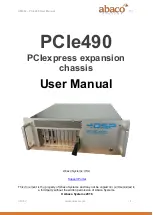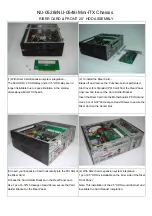
Configuring the system
Power capping
The HPE ProLiant XL family of products provides a power capping feature that operates at the server
enclosure level. The capping feature can be activated using the HPE Apollo Platform Manager. After a
power cap is set for the enclosure, all the resident servers in the enclosure will have the same uniform
power cap applied to them until the cap is either modified or canceled.
Using APM, the enclosure-level power capping feature can be expanded, or different caps can be applied
to user-defined groups by using flexible zones within the same rack. A global power cap can also be
applied to all enclosures with one APM command. For more information on using the APM, see the
HPE
Apollo Platform Manager User Guide
on the Hewlett Packard Enterprise website (
http://www.hpe.com/
support/APM_UG_en
).
Power capping modes
The following Power Management modes are standard and are configurable in the power management
controller:
NOTE:
Mode 4 is only supported through APM.
• Mode 0: No Redundancy
All power-capping is disabled. This mode can be used to minimize any possible performance impact of
power-capping logic.
• Mode 1: Max Performance with Redundancy
This is the default power capping mode. This mode allows the maximum number of nodes to run by
engaging power-capping if the power draw from the chassis attempts to exceed the load supported by
the active power supplies. In this mode, the system is expected to survive (with the possibility of
degraded performance) an unexpected power loss to one or more of the power supplies.
• Mode 2: Not supported
• Mode 3: User Configurable Mode
The user can specify a valid power cap value from a pre-defined range. A cap cannot be set below a
minimum or above a maximum. The cap includes all server nodes, fans, and drives. User configurable
mode requires an iLO Scale Out or iLO Advanced license.
• Mode 4: Rack Level Dynamic Power Capping Mode
In conjunction with APM, the user can specify a maximum power capacity for the entire rack. The APM
dynamically allocates power to the applicable chassis within the rack to maximize performance given
the available power. For more information, see the
HPE Apollo Platform Manager User Guide
on the
Hewlett Packard Enterprise website (
http://www.hpe.com/support/APM_UG_en
).
• Mode 5: Power Feed Redundancy Mode
When used with an A+B power feed configuration, Power Feed Redundancy Mode throttles the
system 100%, bringing the nodes to a complete stop if a power feed loss is deduced. Full throttling
continues until the power feed is brought back online. In this mode, the system is expected to survive
an unexpected loss of an entire power feed to half of the power supplies.
70
Configuring the system







































